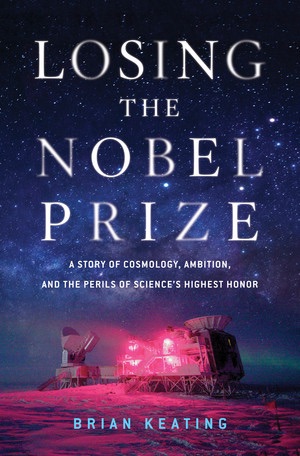Review: Losing the Nobel Prizeby Jeff Foust
|
| “Like many early founders in Silicon Valley, where my initial ideas for BICEP were first sparked, I had been forced out,” Keating writes. “I felt like an astronomical version of Eduardo Saverin.” |
Among those watching the webcast of the press conference was Brian Keating, an astronomer at the University of California San Diego. He was part of the BICEP2 team but was not as excited as his counterparts at the press conference across the country. Although he led the development of the original BICEP telescope and was part of the BICEP2 team, he felt pushed aside by his counterparts on the project, in part because he was also involved with another project viewed by many as a competitor to BICEP2. Watching from the sidelines, he felt he was missing his best chance to win a Nobel.
However, within months, so did everyone else involved with BICEP2. Later analysis of the data showed that what BICEP2 has detected was not the signature of primordial gravitational waves from the early universe’s inflationary epoch, but rather ordinary dust in our own Milky Way galaxy, whose signature turned out to be much higher the BICEP2 team had estimated.
In Losing the Nobel Prize, Keating tells the story of BICEP2 from his insider’s point of view. The book is part memoir about his scientific career and personal life, part science book on cosmology, but also part criticism of the Nobel Prize itself, which he argues is no longer in step with how science works.
Keating started work on the original BICEP while a postdoc at Caltech in the early 2000s (after effectively being fired from an earlier postdoc position at Stanford, where he spent more time thinking about such telescopes than what he was hired to do), winning over colleagues there. That telescope worked well, but he and others concluded a more advanced, and sensitive, telescope would be needed to detect polarization of the cosmic microwave background. But for BICEP2 he would be part of a larger team, and one that he felt his role was increasingly minimized.
“Like many early founders in Silicon Valley, where my initial ideas for BICEP were first sparked, I had been forced out,” he writes. “I felt like an astronomical version of Eduardo Saverin, the Facebook cofounder who sued Mark Zuckerberg after his ownership interest was radically diluted.”
A theme of the book is that the behavior of the BICEP2 team, including pushing aside people like Keating as well as that grand press conference, was driven by the pursuit of a Nobel Prize. There was, certainly, a concern about being scooped by ESA’s Planck mission, which drove the team to announce its results at that March 2014 press conference even though they had not even been submitted for peer review.
| “The Nobel Prize today is a reward mechanism that discourages collaboration, celebrates authority, and sets up a rat race where claim-staking, speed, and greed are encouraged,” he argues. |
“For BICEP2, the standard practice—a months-long peer review process, which would then be followed by a press release—had many disadvantages, any of which, individually, were worrisome,” he writes. Submitting a paper for peer review would have tipped off competitors, who would likely be the ones asked to review the results, and there was a chance that they could have published their results first. They decided instead to release the paper on the arXiv repository to allow everyone to review it—but that doesn’t explain their high-profile press briefing that attracted attention and, ultimately, infamy when the results fell through.
Keating uses the book to point out flaws with the approach used to award Nobel Prizes in the sciences. “The Nobel Prize today is a reward mechanism that discourages collaboration, celebrates authority, and sets up a rat race where claim-staking, speed, and greed are encouraged,” he argues. Several chapters in the book address that issue, and he offers some reforms, such as removing the current limit of no more than three individuals sharing a single prize, which is at odds with the current nature of science where research is done by teams of hundreds or even thousands of researchers. He also supports allowing for posthumous awards and even the creation of new categories of awards in other fields that didn’t exist at the time the Nobels were established.
He acknowledges that losing his best chance for a Nobel involved “disappointment, anger, and maybe a little bit of bitterness,” but that alone didn’t motivate him to write this book. And while that little bit of bitterness might peek through from time to time in the book, Losing the Nobel Prize is a broader look at one scientist’s work and the influence, good and bad, one prize plays on that research.
Note: we are temporarily moderating all comments subcommitted to deal with a surge in spam.
